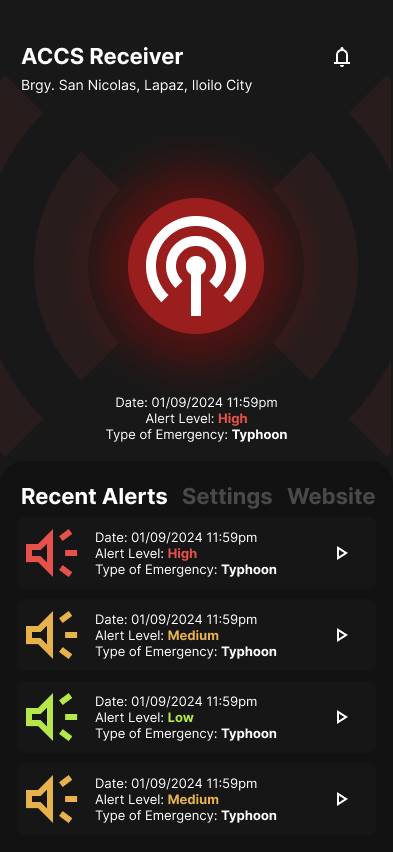Alerto PH
Critical Communication System

High-Tech Features

User Experience

VIsual Design

Mobile Application

Keep People Safe & Informed
ALERTO is a cutting-edge, innovative and transformative voice messaging service solution which facilitates natural-voice and multilingual voice messages, allowing for efficient communication to millions during critical situations.
It is a solution which can enhance disaster and risk management while keeping communities informed and safe.
The system integrates innovation with necessity by offering a comprehensive voice-messaging service that supports more than calamity response but as well as tourism promotion, community outreach, and timely announcements. Its primary feature is the seamless dissemination of critical information, transcending communication barriers and ensuring that every corner of a given jurisdiction receives vital updates.
The platform acts as a lifeline, connecting local government departments with citizens during both emergencies and times of peace. It ensures a steady flow of information that enhances both crisis management and community engagement.

Key Features and Advantages
Real-Time Voice and Multimedia Messaging
ALERTO provides instant communication through mobile phone alerts ensuring that real news and critical information is delivered promptly to stakeholders.
Extensive Data Networks
ALERTO integrates with different communication platforms like mobile networks and WIFI networks allowing for a versatile and comprehensive alert system.
Automated and Customizable Alerts
The platform offers automated message scheduling for recurring alerts and the ability to customize messages based on the type of emergency or community need.
Centralized Control and Coordination
Local Government Units (LGU) can control and coordinate communications from a centralized hub, ensuring consistent and organized dissemination of information across all departments.

Wide Coverage Area
ALERTO can cover an entire province, entire city or municipality, and even an entire barangay in both urban and remote areas by utilizing communication channels to ensure that everyone, even those in isolated locations, receives vital updates.
Scalability and Cost-Effectiveness
Designed to be affordable, the system enables the delivery of messages at a low cost. It can also scale up to accommodate varying levels of communication needs, from small communities to entire provinces.
Misinformation Countermeasure
ALERTO focuses on combating fake news by providing verified and accurate real-time updates, ensuring that communities receive reliable information during crises.
Geotargeted Alerts
The system can send location-specific alerts through the targeted barangay system, making it easier to notify residents within high-risk zones or targeted areas during emergencies.
Related Case Studies

Scenarios
Here are some scenarios where voice communication tools can play a critical role in disaster preparedness and emergency response by ensuring timely and accessible information for all, including those in vulnerable and hard-to-reach areas.
NDRRMC’s Use of Emergency Cell Broadcast System (ECBS) in the Philippines
- The National Disaster Risk Reduction and Management Council (NDRRMC) has utilized the Emergency Cell Broadcast System (ECBS) to send voice and text alerts during disasters like typhoons, earthquakes, and volcanic eruptions.
- ECBS is a GSM-based system capable of sending alerts in real-time through voice or text messages to all mobile phones within a targeted area. The system is integrated with the country’s telecommunications companies and is part of a broader disaster preparedness and response strategy.
- The system proved effective during Typhoon Ulysses (Vamco) in 2020, where alerts sent via ECBS prompted citizens to evacuate from high-risk areas. The real-time notifications significantly reduced casualties and improved the response rate among local government units and communities.
Australia’s National Emergency Warning System (NEWS)
- Following the devastating bushfires in 2009, the Australian government implemented the National Emergency Warning System (NEWS) to improve emergency communication.
- NEWS is designed to send voice messages, text alerts, and emails to people in affected areas based on their location. The system is operated by state and territory emergency services and relies on telecommunications infrastructure to disseminate messages quickly.
- During the 2019-2020 bushfire season, the system was used extensively to deliver evacuation orders and updates, helping save lives by keeping communities informed in real-time. The use of voice messages was especially effective in reaching vulnerable populations, such as the elderly, who might not actively check text messages or emails.
Japan’s Nationwide Emergency Alert System (J-Alert)
- Japan’s J-Alert system is a nationwide early warning system used by the government to communicate with the public during disasters such as earthquakes, tsunamis, and missile threats.
- The J-Alert system sends alerts via radio waves, triggering sirens, TV broadcasts, and automated voice messages. It also connects with mobile phones, broadcasting messages directly to citizens in affected areas.
- During the 2011 Tohoku earthquake and tsunami, J-Alert delivered immediate voice and text alerts to residents in coastal areas, enabling them to evacuate quickly. The system is credited with saving thousands of lives by ensuring prompt dissemination of life-saving information.
United States’ Integrated Public Alert and Warning System (IPAWS)
- The Integrated Public Alert and Warning System (IPAWS) is a U.S. federal initiative designed to provide critical information during emergencies via multiple communication channels, including voice messages.
- IPAWS integrates the Emergency Alert System (EAS), Wireless Emergency Alerts (WEA), and NOAA Weather Radio, among others. It can broadcast voice messages over radio, TV, and mobile phones and is used for both local and national emergencies.
- IPAWS has been activated during events like hurricanes, wildfires, and Amber Alerts. The system’s ability to send voice alerts ensures that even those without access to text or internet-based alerts are informed. For instance, during Hurricane Irma in 2017, voice alerts broadcast over radio and TV guided evacuations and provided timely updates.
India’s Common Alerting Protocol (CAP) System
- India has implemented a Common Alerting Protocol (CAP) system, which is used by disaster management authorities to send alerts during emergencies such as floods, cyclones, and other natural disasters.
- The CAP system integrates various communication channels, including voice, text, and social media. During cyclones, voice alerts are sent via phone networks, particularly to coastal communities where evacuation and preparedness are critical.
- The system was effectively used during Cyclone Fani in 2019. Voice alerts were sent to millions of residents, directing them to evacuation centers and providing real-time updates on the storm’s progression. The timely communication contributed to a lower casualty rate compared to previous cyclones.
Launched Apps
Average App Rating
App Downloads
“As a local government official in the Philippines, I’ve seen firsthand how crucial effective communication is, especially in times of crisis. Our decision to adopt the ALERTO Communications System has been nothing short of transformative for our disaster preparedness and community outreach efforts.” – SIR JOHN
“The ALERTO system has truly lived up to its promise of delivering critical information swiftly and efficiently. During recent typhoons and flood warnings, our communities received real-time voice alerts and multimedia messages, guiding them with clear evacuation instructions. The system’s coverage ensured that even remote areas with limited access to internet or mobile data were reached, which was a game-changer for us.”- MAAM QUEENIE
“One of the most impressive features is how affordable it is to operate. With the investment spread over a significant period, we’re able to send messages to every household for just a fraction of what traditional SMS services cost. The scalability of the system allows us to expand communication as needed, whether for disaster alerts, community announcements, or even tourism promotion.”- SIR TJ
“In today’s digital age, fake news and misinformation are constant challenges. ALERTO has been instrumental in delivering verified and accurate updates directly to our residents. We’ve seen a noticeable decrease in panic and confusion during emergencies because people now trust the official information they receive.”- MAAM RHOSE
“Beyond disaster management, we’ve used ALERTO to enhance community outreach. From announcing public events to promoting local businesses, the platform’s versatility has helped us keep everyone informed and connected. The voice messaging feature has been particularly effective for reaching older residents who may not be tech-savvy.”- SIR MARK
